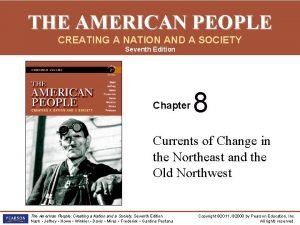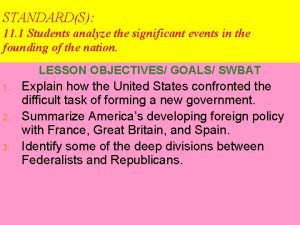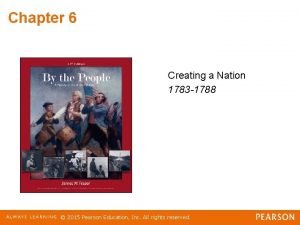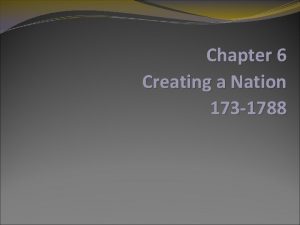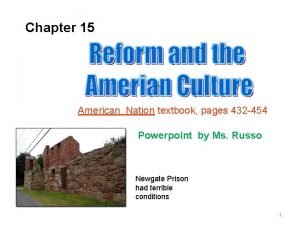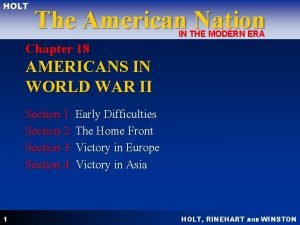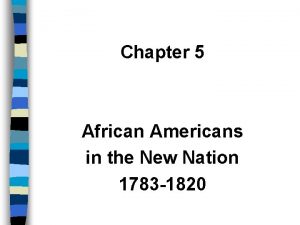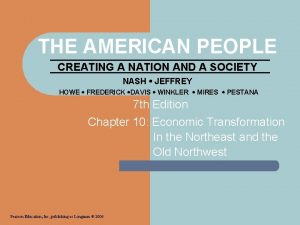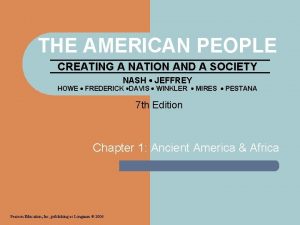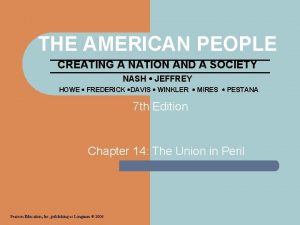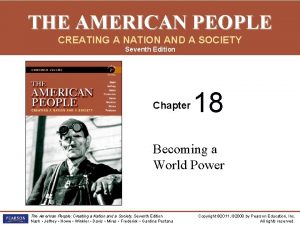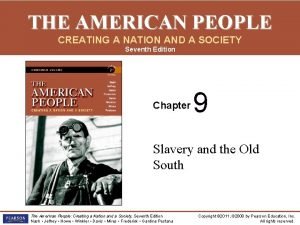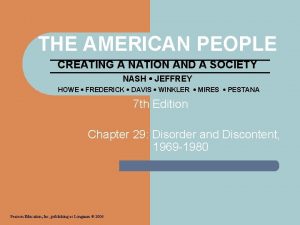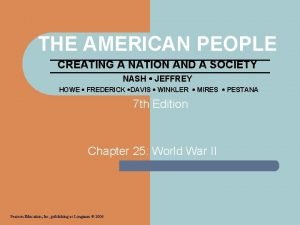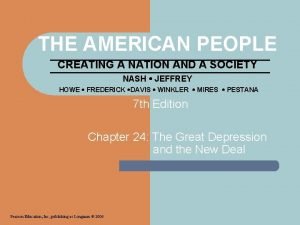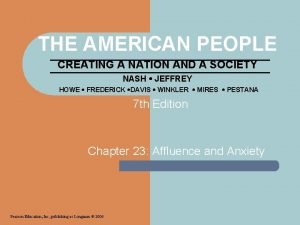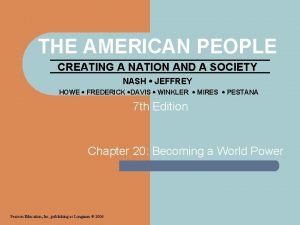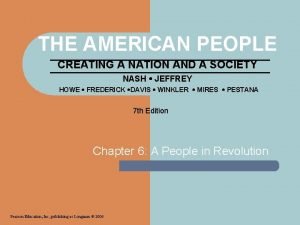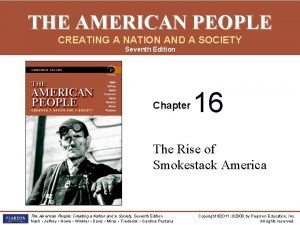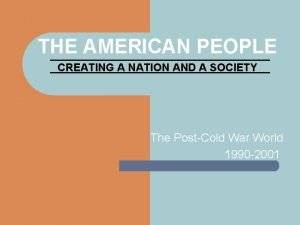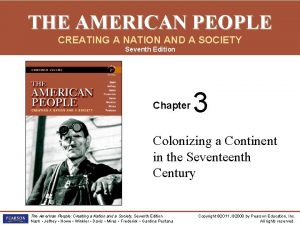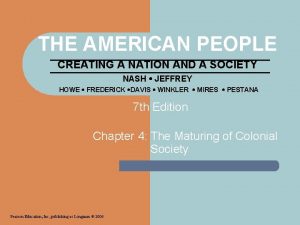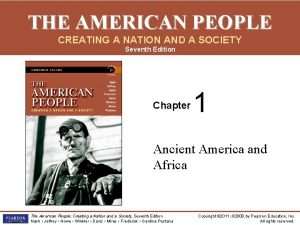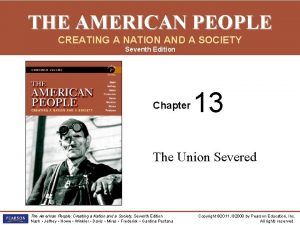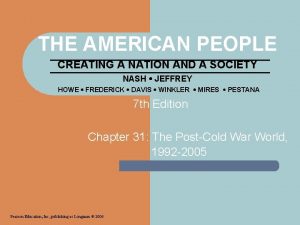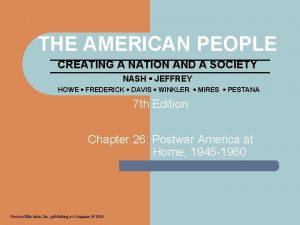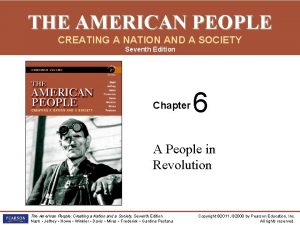THE AMERICAN PEOPLE CREATING A NATION AND A





















































- Slides: 53

THE AMERICAN PEOPLE CREATING A NATION AND A SOCIETY NASH JEFFREY HOWE FREDERICK DAVIS WINKLER MIRES PESTANA 7 th Edition Chapter 18: The Rise of Smokestack America Pearson Education, Inc, publishing as Longman © 2006

THE TEXTURE OF INDUSTRIAL PROGRESS l By 1900, manufacturing was the leading source of economic growth – – l l l Three times as many goods person existed as in 1860 Per capita income increased 2 percent a year, though many people did not gain at all Big business became the characteristic form of economic organization New regions grew in industrial importance The growth of heavy industry helps explain these gains

TECHNOLOGICAL INNOVATIONS l l Advances in technology allowed production to be more efficient which in turn generated new needs and further innovations The Bessemer conversion process contributed to the rapid expansion of the steel industry – – – l Andrew Carnegie acquired access to raw materials and markets and brought all stages of steel manufacturing into one mill. Prices fell and production rose The production of a cheaper, stronger and more durable material than iron created new goods, new demands, and new markets and stimulated further technological change New power sources were at the heart of America’s shift to mass production. – – – In 1869 half the nation’s power came from water The opening of new anthracite deposits dropped the price of coal and by 1900, steam engines generated 80 percent of the nation’s energy supply The work of Thomas Edison helped electricity to replace steam l l By 1880 Edison had a workable and safe light bulb and a company in New York to build the electric generating station to provide electricity to the city’s customers Experimenting with electric generators led to the development of the electric machine

Steel: The Engine of Industrial Growth

RAILROADS: Pioneers of Big Business l Completion of efficient and speedy national transportation and communications networks encouraged mass production and mass marketing – – l Railroads were the first gigantic corporations in America and a great modernizing force – – – l Federal and state governments vigorously promoted railroad construction with land grants from the public domain The first transcontinental railroad was finished in 1869 and by the 1880 s, four additional transcontinental lines and miles of feeder and branch roads had been laid Costs of construction required huge amounts of capital while the numbers of workers and the operation of the business required new management techniques The high cost of running a railroad necessitated cut-throat business practices Railroads often tried to control costs and counter falling prices by slashing wages leading to powerful worker unrest In 1854, Daniel Mc. Callum worked out a system that divided responsibilities in a company and ensured a regular flow of information – Other large scale industries copied the new system which effectively distributed work and separated management from the operations

GROWTH IN OTHER INDUSTRIES l l By the last quarter of the century, the textile, metal and machinery industries equaled the railroads in size There were two major ways to expand business 1. 2. l l Vertical Integration: adding operations before (backward) or after (forward) the production process which allowed the achievement of economies of scale through more efficient management techniques Horizontal Integration: the combination of multiple similar business ventures under one “umbrella” in order to gain a monopoly in a particular market to eliminate competition and stabilize prices As businesses grew and eliminated competition, business ownership became increasingly concentrated Corporations could raise funds by selling stock, could use limited liability to protect investors’ personal assets, and could use the corporation’s legal identity to survive the death of original and subsequent shareholders

FINANCING POSTWAR GROWTH l British, French and German investors contributed onethird of the more than $10 billion needed to build the American railroad system – l Americans also began to devote an increasing percentage of the national income to investment rather than consumption Investment bankers played a new and significant role in transferring resources to economic enterprises – Marketed investment opportunities, bought up blocks of corporate bonds at a discount for interested investors and sold stocks

AMERICAN INDUSTRY AND THE WORLD l The second stage of the Industrial Revolution was marked by the application of science and technology to manufacturing and by the creation of new ways to mass-produce goods – – l Great Britain, Germany and the U. S. produced two-thirds of the world’s manufactured products between 1870 and 1930 – l U. S. was the leader in developing techniques of mass production Germany excelled in using science and technology to reshape production As American and German businesses developed large new enterprises, introduced new ways of organizing and efficiently managing them, invested in equipment and promoted research, Great Britain lost ground American success led to ties around the world, which meant that events elsewhere in the world could affect the American economy

European and American Industrial Investment, 1900

AN ERRATIC GLOBAL ECONOMY l The United States suffered depressions from 1873 to 1879 and 1893 to 1897 that were industrial, intense and accompanied by widespread unemployment – l Also related to economic declines in European industrial nations During expansionary years, manufacturers flooded markets with goods – As the market became saturated, a downward spiral followed


POLLUTION l Widespread pollution worried most Americans less than fluctuations in the economic cycle but they still caused severe problems – – – l Coke ovens poured smoke, soot, and ashes into the air Coal tar was dumped, making the soil so acid nothing could grow on it When industrial, human and animal wastes were channeled into rivers, they killed fish and other forms of marine life and plants Intellectual rationale stressed growth, development and the rapid exploitation of the country’s resources

URBAN EXPANSION IN THE INDUSTRIAL AGE l As manufacturers shifted from water to steam they favored urban locations that also offered greater opportunities for their workers – – – Industry fueled urban expansion between 1870 and 1900 Many cities increased rapidly in size with cities in the Far West growing fastest of all By 1900, 40 percent of Americans were urban dwellers

A GROWING POPULATION l The American population grew about 2 percent a year but cities grew more rapidly – l Rural Americans were “pushed” toward cities by agricultural modernization and “pulled” by the promise of employment – – l Urban growth was based upon attraction of newcomers from farms, small towns and abroad Higher city costs did not absorb all of the higher city wages. The city also offered a variety of entertainment and amenities not available in the countryside Southern blacks, often single and young, also went to the cities, especially in the South


THE NEW IMMIGRATION, 1880 -1900 l 40 million immigrants came to the United States between 1815 and 1915 and another 20 million to Canada and Latin America – – l Over the course of the century, the sources of immigrants for the United States changed – – – l Three-quarters of those coming in the last quarter of the century stayed in the Northeast Many of the rest settled in cities across the country where they soon outnumbered native-born whites Until 1880, three-quarters of those coming to the U. S. (“old immigrants”) came from the British Isles, Germany, and Scandinavia By 1890, these nationalities were only 60 percent of the total with the rest (“new immigrants”) coming from southern and eastern Europe Italian Catholics were the most numerous followed by Eastern European Jews and then Slavs Large numbers were the result of cheaper, faster and better transportation – – – Dissatisfaction with life at home was basic to the decision to migrate Efforts to modernize European economies also stimulated immigration Government policies pushed others to leave Opportunity also lured thousands to the United States The phenomenon of immigrants being recruited through the reports and efforts of their predecessors is known as “chain migration”


Migration to the United States, 1860 -1910

THE NEW IMMIGRATION, 1880 -1900 l Europeans came primarily to work – – – l l When times were good and American industry needed large numbers of unskilled workers, migration was heavy Many workers hoped to earn enough money in the United States to realize their ambitions at home – l Twenty to thirty percent of Italians returned home While most Mexicans arrived in the twentieth century, overpopulation and new land policies did lead some Mexicans to come to the United States at the end of the nineteenth century – l Most were young, single men with few skills Jews most often came in family groups Women predominated among the Irish Most ended up in the Southwest and West working for the railroads and mines. Overpopulation, depressed conditions, unemployment and crop failures drove 264, 000 Chinese to the United States between 1860 and 1900 – – – Most stayed on the West Coast Tended to be unskilled males who planned to return home to their families A limited number of Chinese women were brought over as prostitutes



THE INDUSTRIAL CITY, 1880 -1900 l Late nineteenth century industrial cities had new physical and social arrangements that attracted widespread comment – – – – l The antebellum walking city disappeared Central business districts emerged Surrounding the business center were areas of light manufacturing and wholesale activity with housing for workers Beyond working-class neighborhoods stretched middle-class residential areas. Then came the suburbs Scattered throughout the city were pockets of industrial activity surrounded by crowded working-class housing New living arrangements were more segregated by race and class. Homogenous social and economic neighborhoods emerged Transportation improvements affected the development of American cities – – – In the 1820 s and 1830 s, horse-drawn omnibuses took 10 and 12 people to work In the 1850 s many cities introduced faster and bigger horse railways, allowing the city to expand outward about 4 miles though ridership was limited by high fares Cable cars, trolleys and subways after 1880 further extended city boundaries

NEIGHBORHOODS AND NEIGHBORHOOD LIFE l l Working-class neighborhoods clustered near the city’s center Ethnic groups gathered in particular neighborhoods, often located near industries requiring their labor – l Working class neighborhoods were crowded, unsanitary, and dangerous – – – l l Except for Chinatowns there were not ethnic ghettos Urban death rates were high Only at the turn of the century did the public health movement begin to ameliorate the conditions Not every working class family lived in abject circumstances especially if they were skilled Community cohesion and a wide range of institutions and associations became the saving force for many immigrants African Americans lived in the worst conditions though a rich religious and associational life tempered the suffering – Some urban African Americans rose to the middle class

STREETCAR SUBURBS l l The fringes of the city contained the houses of the substantial middle class and the rich Public transportation allowed them to work in the city center and live outside

THE SOCIAL GEOGRAPHY OF THE CITIES l In cities, people were sorted by class, income, occupation and race all of which affected how people lived as well as family size and domestic life – l While middle class families were shrinking over the course of century, immigrant and working class families remained large which made sense since the children usually worked Because they lived in separate areas, middle and upper class people generally had little idea of the life lived by the working class – Ignorance led to distorted views and social disapproval

THE LIFE OF THE MIDDLE CLASS l Between 1865 and 1890, average middle-class income rose about 30 percent – – – l By 1900, 36 percent of urban families owned their homes. Industrial expansion raised living standards for an increasing number of Americans They could purchase dozens of products, manufactured, packaged and promoted in and explosion of technological inventions and shrewd marketing techniques More leisure time and greater access to consumer goods signaled industrialism’s power to transform the lives of middleclass Americans – – Plentiful immigrant servant girls relieved urban middle class wives of many housekeeping chores New department stores fed the desire for material possessions and revolutionized retailing

NEW FREEDOMS FOR MIDDLECLASS WOMEN l l Several states granted women more property rights in marriage Clothing changes gave women more freedom and encouraged greater activity including sports Women joined organizations of all kinds where they gained organizational experience, awareness of their talents and contact with new peoples Job opportunities for educated middle class women were usually limited to social services and teaching – l After the Civil War, educational opportunities for women expanded – – – l By the 1890 s, also had opportunities in nursing, office work and department stores New women’s colleges offered programs similar to those at competitive men’s colleges. Midwestern and western state schools dropped prohibitions against women By 1900, 20 percent of college graduates were women Higher education prepared middle-class women for conventional female roles as well as for work and public service By the early twentieth-century, the number of women professionals was increasing at three times the rate for men Women had more freedom because they were having fewer babies – – – In 1900, one in five married women was childless Advances in birth control technology helped make new patterns possible Decreasing family size and an increase in the divorce rate fueled male fears

MALE MOBILITY AND THE SUCCESS ETHIC l l New job opportunities opened for men, especially as the lower ranks of the white-collar world became more specialized To prepare for the new careers, Americans required more education – – – l Number of public high schools increased from 160 in 1870 to 6, 000 by 1900 By 1900 the majority of states had compulsory attendance laws Higher education also expanded in this period and the number of students in colleges and universities nearly doubled between 1870 and 1900 The growth of Harvard under Charles Elliot reflected the new stature of the university in American life – – – Generous gifts from businessmen allowed the founding of leading research universities These developments led to greater specialization and professionalism in education, law, medicine and business By 1890 with government licensing and the rise of professional schools, the word career began to take on its modern meaning

MALE MOBILITY AND THE SUCCESS ETHIC l As large companies formed and became bureaucratized, business required many more managerial positions – l As the public sector expanded, new careers in social services and government opened up as well The social ethic of the age stressed that economic rewards were available to anyone who fervently sought them – – Writers, clergymen, lecturers, and politicians propagated the rags-to-riches tradition of upward mobility Self-help manuals outlined the steps to success for self-made men were widely available

INDUSTRIAL WORK AND THE LABORING CLASS l l Most working class Americans labored long hours on dangerous factory floors, in cramped sweatshops or in steamy basement kitchens for meager wages As industrialization transformed the nature of work and the composition of the workforce, traditional, opportunities for mobility and even for a secure livelihood slipped from the grasp of many working-class Americans

THE IMPACT OF ETHNIC DIVERSITY l Immigrants made up a large portion of the working class in the late nineteenth century – – l Formed 20 percent of the labor force and more than 40 percent of the laborers in the manufacturing and extractive industries Accounted for more than half the working-class population in cities Occupation was related to ethnic background and experience – – Native born Protestant whites held a disproportionate share of wellpaying skilled jobs Skilled northern European immigrants filled most of the middle-rank positions, often having held similar jobs in their homeland Most of the “new immigrants” from southern and central Europe had no urban industrial experience and labored in unskilled, dirty jobs near the bottom of the occupational ladder Blacks were at the bottom of occupational ladder with the most marginal positions


THE CHANGING NATURE OF WORK l The rise of big business, characterized by mechanization and mass production, changed the size and shape of the workforce and the nature of the work itself – l More and more Americans became wage earners with the fastest expansion in the unskilled and semiskilled ranks Need for skilled workers remained because new positions appeared as industries expanded and changed – – All skilled workers faced the possibility that technical advances would eliminate their jobs or that employers would hire unskilled workers to take over parts of their jobs New methods of production and organization undermined the position of skilled workers

WORK SETTINGS AND EXPERIENCES l l A majority of Americans now labored in a factory setting or small sweatshop where the pressure to produce was relentless because volume determined pay The organization of work divided workers with those paid by the piece competing and those in factories separated into small work groups – l l Workdays were usually ten hours a day, six days a week Work was uncomfortable, dangerous, and usually repetitively boring. – – – l Clustering of ethnic groups in certain types of work also undermined workingclass solidarity Employers were rarely concerned with the health or safety of their workers Accident rates in the United States far exceeded those of Europe’s industrial nations with 35, 000 American deaths per year Nationwide, nearly one quarter of the men reaching age 20 in 1880 would not live to see 44 New arrangements helped humanize the workplace – The foreman was a powerful figure in workers’ lives

THE WORKER’S SHARE IN INDUSTRIAL PROGRESS l In 1890, the top 1 percent of American families possessed more than a quarter of the wealth – l Working class Americans made up more than 50 percent of the labor force. – – l l Average real wages rose more than 50 percent between 1860 and 1900 Skilled manufacturing workers, about one-tenth of the nonagricultural working class saw their wages rise by 74 percent Wages of unskilled workers increased by only 31 percent The differential grew as the century drew to a close American workers had more material comforts than their European counterparts but there were great disparities of income that translated into lifestyle differences For workers without steady employment, rising real wages were meaningless – l Top 10 percent held a 73 percent share Unemployment insurance, social security and disability insurance did not exist A working-class family’s standard of living often depended on its number of workers though married women often contributed by taking in sewing, laundry, and boarders



THE FAMILY ECONOMY l Children often worked outside the home – – l Even more children over the age of 14 worked, daughters as well as sons – l – – – l Young women from immigrant families were more likely to work than were young American women. By 1900, nearly 20 percent of American women were in the labor force – l In 1880 one-fifth of the nation’s children between 10 and 14 held jobs Child labor was closely linked to a father’s income, which depended on skill, ethnic background and occupation Employed women earned far less than men By the 1890 s, office work, nursing and clerking in department stores offered young women attractive opportunities Ethnic taboos and cultural traditions helped shape choices Domestic service was arduous and dominated by Irish, Scandinavians and blacks Dismal job choices drove some women to prostitution which increased in the late nineteenth century Late nineteenth century working class families operated as cooperative economic units – – Housework was time-consuming and arduous Married women bore managed the family resources Women also supplemented family income by taking in work Black women worked outside the home both before and after marriage, mostly as domestics or laundresses


CAPITAL VERSUS LABOR l Class conflict characterized late-nineteenthcentury industrial life – l Many workers rejected their employers’ emphasis on individual gain at the expense of collective good Fashioning their arguments from their republican legacy, workers claimed that the degradation of the country’s citizen laborers threatened to undermine the republic itself

ON-THE-JOB PROTESTS l Workers and employers constantly struggled for control of the workplace – – l l Skilled workers had indispensable knowledge about the production process as well as practical experience and were in a key position to direct on-the-job actions Sometimes they struggled to retain control over critical work actions and other times they hoped to humanize work Workers sought to control the pace of production in factories and developed strong-arm tactics to encourage solidarity within the shop Protest came in the guise of absenteeism, drunkenness, general inefficiency, and quitting work altogether

STRIKE ACTIVITY AFTER 1876 l l The most direct methodology to adjust conditions in the workplace was the strike 1877 Railroad Workers’ Strike: first and most violent nationwide industrial strike caused by the railroad owners’ decision to reduce wages – – – l l An erratic economy, high unemployment rates and the lack of job security all contributed to the conflagration More than 100 people died before federal troops ended the strike Time and again, middle and upper class Americans would turn to the power of the state to crush labor activism Between 1881 and 1905 a total of 36, 757 strikes erupted, involving more than 6 million workers Strikes in the nineteenth century usually happened at the workplace, replacing neighborhood riots – – – As collective action spread, unions began to play a more active role in arbitration of grievances, conduction 60 percent of the strikes between 1881 and 1905 As union leaders realized the importance of collective action, they worked to coordinate local and national efforts Coordination between workplaces performing the same work led to uniform wages and hours

LABOR ORGANIZING, 1865 -1900 l Civil War experience colored postwar labor organizing – l In 1866 several craft unions and reform groups formed the National Labor Union (NLU) – l Had 300, 000 members by the early 1870 s and supported a wide range of causes Few workers saw employers as a hostile class or wanted to destroy the economic system – l Workers who had fought to save the Union argued that wartime sacrifices justified efforts for justice and equality in the workplace Did believe bosses were dangerous tyrants whose demands for their time threatened to turn citizens into slaves While the NLU was killed by the depression of 1873, its goals lived on

THE KNIGHTS OF LABOR AND THE AFL l The Noble and Holy Order of Knights of Labor was founded in 1869 and became public in 1879 when Terence V. Powderly was elected Grand Master Workman – – – l l Sought to secure the workers the full enjoyment of the wealth they create Proposed a cooperative system of production that would provide workers with the economic independence necessary for citizenship, and an eight hour day that would allow them time for moral, intellectual and political pursuits Open to all American “producers, ” defined as contributing members of society and only excluding the idle and corrupt Although Powderly frowned on strikes, the organization reaped the benefit of grassroots strike activity In 1886, the Haymarket Riot in Chicago caused such a growth in labor militancy that in a single year the membership of the Knights of Labor ballooned from 100, 000 to 700, 000 – – The “riot” was a peaceful protest connected with a lockout at the Mc. Cormick Reaper Works that led to a bomb explosion when the police arrived to break up the crowd Seven policemen died and eight anarchists were tried and convicted—three were executed, one committed suicide and the others served prison terms

THE KNIGHTS OF LABOR AND THE AFL l In 1884 and 1885 the Knights lobbied for a national contract labor law that would demand work contracts and state laws outlawing convict labor – l l Pressed successfully for the creation of a federal Department of Labor The Knights, under a variety of pressures, gradually fizzled so that by 1890, membership plummeted to 100, 000 The American Federation of Labor (AFL), founded in 1886, became the nation’s dominant union in the 1890 s – – The AFL leader Samuel Gompers organized the union as a federation of skilled trades and focused on bread and butter issues such as higher wages, shorter hours, industrial safety and the right to organize He believed in the value of the strike but not in direct political action AFL grew from 140, 000 in 1886 to nearly 1 million by 1900 The AFL did make a brief, halfhearted attempt to unionize women in 1892 but men resented women as coworkers and preferred them to stay at home

WORKING-CLASS SETBACKS l In 1892, silver miners in Coeur d’Alene, Idaho, struck when their employers installed machine drills in the mines, reduced skilled workers to shovelmen, and cut wages – – Owners, supported by state militiamen and the federal government, successfully broke the strike by using scabs and troops Out of the defeat emerged the Western Federation of Miners (WFM) whose chief goal was the eighthour law for miners

THE HOMESTEAD AND PULLMAN STRIKES OF 1892 AND 1894 l In 1892 Andrew Carnegie and Henry Clay Frick tried to break the union at the Homestead Steel mills in Pennsylvania – – l l l After three months of negotiations over a new wage contract, Frick locked out the workers and hired Pinkerton guards whom the steelworkers attacked The governor of Pennsylvania sent 8000 troops to crush the strike and the union 1893 brought a serious depression and more setbacks for labor Eugene Debs created the American Railway Union with a membership of 150, 000 railroadmen and a victory against the Great Northern Railroad The Pullman Company cut wages by one-third and laid off many workers without reducing rent or prices in the company town where most workers lived – – – Workers joined the ARU in 1894 and struck When Pullman refused to arbitrate in June, Debs led the ARU in a sympathy strike with orders to use no violence and stop no trains As the strike spread, the General Management Association (GMA) came to Pullman’s support, hired strikebreakers and appealed to the state and federal governments for military and judicial support U. S. Attorney General obtained a court injunction declaring the strike to be a “conspiracy in restraint of trade” and President Cleveland ordered federal troops to crush the strikers, leading to escalating violence The strike collapsed, Debs became a Socialist, and the ARU was dead In 1895, the Supreme Court decision in In re Debs upheld the legality of using an injunction to stop a strike

THE HOMESTEAD AND PULLMAN STRIKES OF 1892 AND 1894 l Middle and upper class Americans believed unions were un-American – l l The severe depressions of the 1870 s and 1890 s further undermined workingclass activism Even in good times, workers were reluctant to organize – – l l l Most employers violently resisted union demands as infringements of their right to manage their business Diverse work settings and ethnic differences made it difficult for workers to recognize common bonds Many native born American workers clung to the tradition of individualism of dreamed of entering the middle class Ethnic and religious diversity complicated forging a common front Foreigners planning to return to their homeland had limited interest in changing conditions in the U. S. and often took jobs as scabs 1870 s and 1880 s white workers in the West began to blame Chinese for economic hardships leading to the 1882 Chinese Exclusion Act which was made permanent in 1902 Many immigrants, especially skilled ones, supported unions The importance of workers’ organizations lay not so much in their successful struggles and protests as in the implicit criticism they offered of American society

THE BALANCE SHEET l l Except for skilled workers, most laboring people did not earn enough to share in the bounty that industrialization created. Culture and background influenced worker perspective about their condition – – – l Workers achieved some occupational mobility, especially across generations Mobility, like occupation, was related to background, cultural attitudes, family size, education and group leadership African Americans and Hispanic Americans enjoyed little mobility Although immigrants’ occupational mobility was limited, other rewards often compensated for the lack of success at the workplace – – Social clubs and fraternal organizations also provided compensation A few rags to riches stories also provided encouragement


DISCOVERING U. S. HISTORY ONLINE Andrew Carnegie http: //www. pbs. org/wgbh/amex/carnegie/ l The Rockefellers http: //www. pbs. org/wgbh/amex/rockefellers/index. html l John D. Rockefeller and the Standard Oil Company http: //www. micheloud. com/FXM/SO/ l Enarco http: //www. enarco. com/home. htm l Angel Island: The Pacific Gateway http: //www. internationalchannel. com/education/angelisl and l

DISCOVERING U. S. HISTORY ONLINE The Great Chicago Fire http: //www. chicagohs. org/fire/index. html l Lower East Side Tenement Museum http: //www. thirteen. org/tenement/index. html l Ellis Island http: //www. ellisisland. com/index. History. html l Nineteenth-Century American Children and What They Read l http: //www. merrycoz. org/kids. htm l Jane Addams http: //www. hullhouse. org/about. asp

DISCOVERING U. S. HISTORY ONLINE Anarchism http: //dwardmac. pitzer. edu/Anarchist_Archives/ l Haymarket http: //www. chicagohistory. org/dramas/ l American Labor History http: //www. geocities. com/College. Park/Quad/6460/Am. L ab. Hist/ l The Samuel Gompers Papers: A Documentary History of the American Working Class http: //www. history. umd. edu/Gompers/index. htm l The Strike at Homestead, 1892 http: //history. osu. edu/projects/Homestead. Strike 1892/ l
 The american people creating a nation and a society
The american people creating a nation and a society Creating a new nation
Creating a new nation Chapter 6 creating a nation
Chapter 6 creating a nation Chapter 6 creating a nation
Chapter 6 creating a nation Nation state vs nation
Nation state vs nation Nation vs state
Nation vs state Nation vs state
Nation vs state American nation textbook
American nation textbook Holt american nation
Holt american nation Chapter 5 african american in the new nation
Chapter 5 african american in the new nation American nation chapter 4
American nation chapter 4 American nation chapter 4
American nation chapter 4 Jeff fort
Jeff fort Folk nation symbols
Folk nation symbols Sureno rules
Sureno rules Mil venn diagram
Mil venn diagram Black eyed peas
Black eyed peas Creating and interpreting graphs and tables
Creating and interpreting graphs and tables Hình ảnh bộ gõ cơ thể búng tay
Hình ảnh bộ gõ cơ thể búng tay Ng-html
Ng-html Bổ thể
Bổ thể Tỉ lệ cơ thể trẻ em
Tỉ lệ cơ thể trẻ em Voi kéo gỗ như thế nào
Voi kéo gỗ như thế nào Tư thế worm breton
Tư thế worm breton Alleluia hat len nguoi oi
Alleluia hat len nguoi oi Các môn thể thao bắt đầu bằng từ đua
Các môn thể thao bắt đầu bằng từ đua Thế nào là hệ số cao nhất
Thế nào là hệ số cao nhất Các châu lục và đại dương trên thế giới
Các châu lục và đại dương trên thế giới Công của trọng lực
Công của trọng lực Trời xanh đây là của chúng ta thể thơ
Trời xanh đây là của chúng ta thể thơ Cách giải mật thư tọa độ
Cách giải mật thư tọa độ Làm thế nào để 102-1=99
Làm thế nào để 102-1=99 độ dài liên kết
độ dài liên kết Các châu lục và đại dương trên thế giới
Các châu lục và đại dương trên thế giới Thể thơ truyền thống
Thể thơ truyền thống Quá trình desamine hóa có thể tạo ra
Quá trình desamine hóa có thể tạo ra Một số thể thơ truyền thống
Một số thể thơ truyền thống Bàn tay mà dây bẩn
Bàn tay mà dây bẩn Vẽ hình chiếu vuông góc của vật thể sau
Vẽ hình chiếu vuông góc của vật thể sau Thế nào là sự mỏi cơ
Thế nào là sự mỏi cơ đặc điểm cơ thể của người tối cổ
đặc điểm cơ thể của người tối cổ V cc
V cc Vẽ hình chiếu đứng bằng cạnh của vật thể
Vẽ hình chiếu đứng bằng cạnh của vật thể Phối cảnh
Phối cảnh Thẻ vin
Thẻ vin đại từ thay thế
đại từ thay thế điện thế nghỉ
điện thế nghỉ Tư thế ngồi viết
Tư thế ngồi viết Diễn thế sinh thái là
Diễn thế sinh thái là Dạng đột biến một nhiễm là
Dạng đột biến một nhiễm là So nguyen to
So nguyen to Tư thế ngồi viết
Tư thế ngồi viết Lời thề hippocrates
Lời thề hippocrates Thiếu nhi thế giới liên hoan
Thiếu nhi thế giới liên hoan
